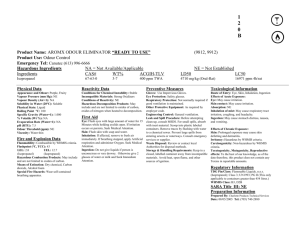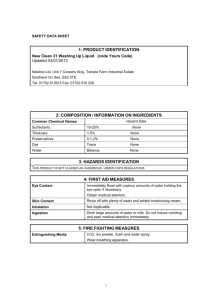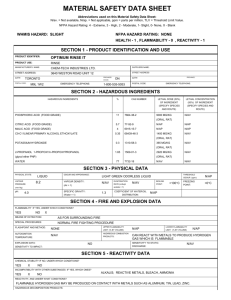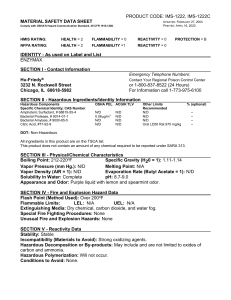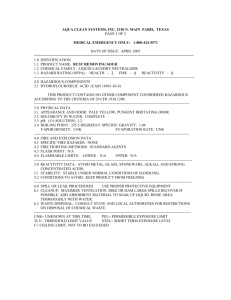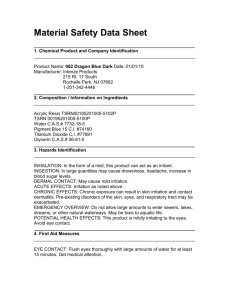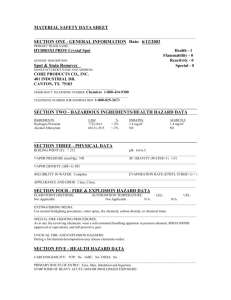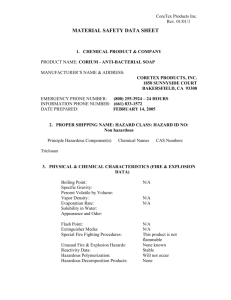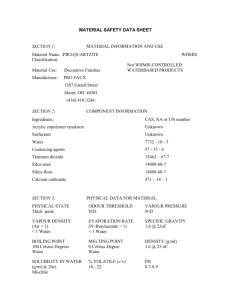First Aid - Swish Maintenance Limited
advertisement
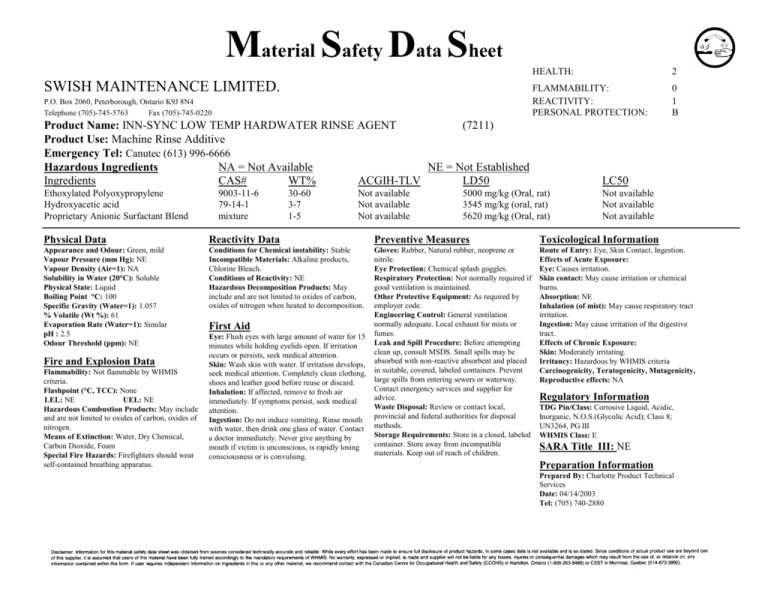
Material Safety Data Sheet SWISH MAINTENANCE LIMITED. P.O. Box 2060, Peterborough, Ontario K9J 8N4 Telephone (705)-745-5763 Fax (705)-745-0220 HEALTH: 2 FLAMMABILITY: REACTIVITY: PERSONAL PROTECTION: 0 1 B Product Name: INN-SYNC LOW TEMP HARDWATER RINSE AGENT (7211) Product Use: Machine Rinse Additive Emergency Tel: Canutec (613) 996-6666 Hazardous Ingredients NA = Not Available NE = Not Established Ingredients CAS# WT% ACGIH-TLV LD50 LC50 Ethoxylated Polyoxypropylene Hydroxyacetic acid Proprietary Anionic Surfactant Blend Not available Not available Not available 9003-11-6 79-14-1 mixture 30-60 3-7 1-5 Not available Not available Not available 5000 mg/kg (Oral, rat) 3545 mg/kg (oral, rat) 5620 mg/kg (Oral, rat) Physical Data Reactivity Data Preventive Measures Toxicological Information Appearance and Odour: Green, mild Vapour Pressure (mm Hg): NE Vapour Density (Air=1): NA Solubility in Water (20°C): Soluble Physical State: Liquid Boiling Point °C: 100 Specific Gravity (Water=1): 1.057 % Volatile (Wt %): 61 Evaporation Rate (Water=1): Similar pH : 2.5 Odour Threshold (ppm): NE Conditions for Chemical instability: Stable Incompatible Materials: Alkaline products, Chlorine Bleach. Conditions of Reactivity: NE Hazardous Decomposition Products: May include and are not limited to oxides of carbon, oxides of nitrogen when heated to decomposition. Gloves: Rubber, Natural rubber, neoprene or nitrile. Eye Protection: Chemical splash goggles. Respiratory Protection: Not normally required if good ventilation is maintained. Other Protective Equipment: As required by employer code. Engineering Control: General ventilation normally adequate. Local exhaust for mists or fumes. Leak and Spill Procedure: Before attempting clean up, consult MSDS. Small spills may be absorbed with non-reactive absorbent and placed in suitable, covered, labeled containers. Prevent large spills from entering sewers or waterway. Contact emergency services and supplier for advice. Waste Disposal: Review or contact local, provincial and federal authorities for disposal methods. Storage Requirements: Store in a closed, labeled container. Store away from incompatible materials. Keep out of reach of children. Route of Entry: Eye, Skin Contact, Ingestion. Effects of Acute Exposure: Eye: Causes irritation. Skin contact: May cause irritation or chemical burns. Absorption: NE Inhalation (of mist): May cause respiratory tract irritation. Ingestion: May cause irritation of the digestive tract. Effects of Chronic Exposure: Skin: Moderately irritating. Irritancy: Hazardous by WHMIS criteria Carcinogenicity, Teratogenicity, Mutagenicity, Reproductive effects: NA Fire and Explosion Data Flammability: Not flammable by WHMIS criteria. Flashpoint (°C, TCC): None LEL: NE UEL: NE Hazardous Combustion Products: May include and are not limited to oxides of carbon, oxides of nitrogen. Means of Extinction: Water, Dry Chemical, Carbon Dioxide, Foam Special Fire Hazards: Firefighters should wear self-contained breathing apparatus. First Aid Eye: Flush eyes with large amount of water for 15 minutes while holding eyelids open. If irritation occurs or persists, seek medical attention. Skin: Wash skin with water. If irritation develops, seek medical attention. Completely clean clothing, shoes and leather good before reuse or discard. Inhalation: If affected, remove to fresh air immediately. If symptoms persist, seek medical attention. Ingestion: Do not induce vomiting. Rinse mouth with water, then drink one glass of water. Contact a doctor immediately. Never give anything by mouth if victim is unconscious, is rapidly losing consciousness or is convulsing. Regulatory Information TDG Pin/Class: Corrosive Liquid, Acidic, Inorganic, N.O.S.(Glycolic Acid); Class 8; UN3264, PG III WHMIS Class: E SARA Title III: NE Preparation Information Prepared By: Charlotte Product Technical Services Date: 04/14/2003 Tel: (705) 740-2880
